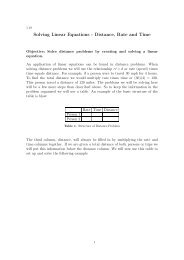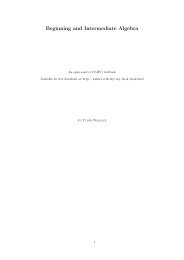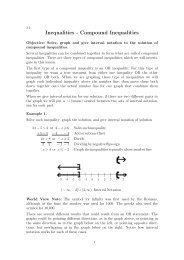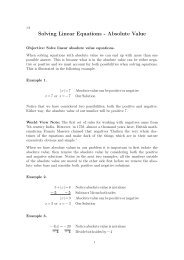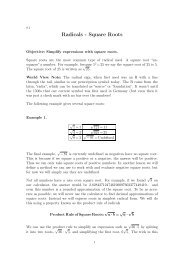Quadratics - Rectangles
Quadratics - Rectangles
Quadratics - Rectangles
Create successful ePaper yourself
Turn your PDF publications into a flip-book with our unique Google optimized e-Paper software.
9.7<br />
<strong>Quadratics</strong> - <strong>Rectangles</strong><br />
Objective: Solve applications of quadratic equations using rectangles.<br />
An application of solving quadratic equations comes from the formula for the area<br />
of a rectangle. The area of a rectangle can be calculated by multiplying the width<br />
by the length. To solve problems with rectangles we will first draw a picture to<br />
represent the problem and use the picture to set up our equation.<br />
Example 1.<br />
The length of a rectangle is 3 more than the width. If the area is 40 square<br />
inches, what are the dimensions?<br />
40 x We do not know the width,x.<br />
x +3 Length is 4 more, orx+4, and area is 40.<br />
x(x + 3)=40 Multiply length by width to get area<br />
x 2 +3x = 40 Distribute<br />
− 40 − 40 Make equation equal zero<br />
x 2 + 3x − 40 =0 Factor<br />
(x − 5)(x + 8)=0 Set each factor equal to zero<br />
x − 5=0 or x + 8=0 Solve each equation<br />
+5+5 − 8 − 8<br />
x =5 or x = − 8 Our x isawidth, cannot be negative.<br />
(5)+3=8 Length isx+3, substitute 5 for x to find length<br />
5 in by 8in Our Solution<br />
The above rectangle problem is very simple as there is only one rectangle<br />
involved. When we compare two rectangles, we may have to get a bit more creative.<br />
Example 2.<br />
If each side of a square is increased by 6, the area is multiplied by 16. Find the<br />
1
side of the original square.<br />
x 2 x Square has all sides the same length<br />
x Area is found by multiplying length by width<br />
16x 2 x +6 Each side is increased by 6,<br />
x +6 Area is 16 times original area<br />
(x + 6)(x +6) = 16x 2 Multiply length by width to get area<br />
x 2 + 12x + 36 = 16x 2 FOIL<br />
− 16x 2 − 16x 2 Make equation equal zero<br />
− 15x 2 + 12x + 36 =0 Divide each term by − 1, changes the signs<br />
15x2 − 12x − 36 =0 Solve using the quadratic formula<br />
x= 12 ± ( − 12)2 �<br />
− 4(15)( − 36)<br />
Evaluate<br />
2(15)<br />
√<br />
16 ± 2304<br />
x =<br />
30<br />
16 ± 48<br />
x = Can<br />
30<br />
′ t have a negative solution, we will only add<br />
x = 60<br />
=2 Ourxis the original square<br />
30<br />
2 Our Solution<br />
Example 3.<br />
The length of a rectangle is 4 ft greater than the width. If each dimension is<br />
increased by 3, the new area will be 33 square feet larger. Find the dimensions of<br />
the original rectangle.<br />
x(x +4) x We don ′ t know width,x, length is 4 more, x +4<br />
x +4 Area is found by multiplying length by width<br />
x(x +4)+33 x +3<br />
Increase each side by 3.<br />
width becomesx+3, length x + 4+3=x+7<br />
x + 7 Area is 33 more than original,x(x +4) + 33<br />
(x +3)(x + 7)=x(x + 4) + 33 Set up equation, length times width is area<br />
x 2 + 10x + 21 =x 2 + 4x + 33 Subtract x 2 from both sides<br />
−x 2 −x 2<br />
10x + 21 = 4x + 33 Move variables to one side<br />
− 4x − 4x Subtract 4x from each side<br />
2
6x + 21 = 33 Subtract 21 from both sides<br />
− 21 − 21<br />
6x = 12 Divide both sides by 6<br />
6 6<br />
x =2 x is the width of the original<br />
(2)+4=6 x +4is the length. Substitute 2 to find<br />
2 ft by 6ft Our Solution<br />
From one rectangle we can find two equations. Perimeter is found by adding all<br />
the sides of a polygon together. A rectangle has two widths and two lengths, both<br />
the same size. So we can use the equation P = 2l + 2w (twice the length plus<br />
twice the width).<br />
Example 4.<br />
The area of a rectangle is 168 cm 2 . The perimeter of the same rectangle is 52 cm.<br />
What are the dimensions of the rectangle?<br />
x We don ′ t know anything about length or width<br />
y Use two variables, x and y<br />
xy = 168 Length times width gives the area.<br />
2x +2y = 52 Also use perimeter formula.<br />
− 2x − 2x Solve by substitution, isolate y<br />
2y = − 2x + 52 Divide each term by 2<br />
2 2 2<br />
y = −x+26 Substitute into area equation<br />
x( −x+26)=168 Distribute<br />
−x 2 + 26x = 168 Divide each term by − 1, changing all the signs<br />
x2 − 26x = − 168<br />
� �2 1<br />
· 26 = 13<br />
2<br />
Solve by completing the square.<br />
2 = 169<br />
�<br />
1<br />
Find number to complete the square:<br />
2 ·b<br />
�2 x2 − 26x + 324 =1 Add 169 to both sides<br />
(x − 13) 2 =1 Factor<br />
x − 13 = ± 1 Square root both sides<br />
+ 13 + 13<br />
x = 13 ± 1 Evaluate<br />
x = 14 or 12 Two options for first side.<br />
y = − (14)+26 = 12 Substitute 14 into y = − x + 26<br />
y = − (12)+26 = 14 Substitute 12 into y = − x + 26<br />
3
12 cm by 14cm Our Solution<br />
Both are the same rectangle, variables switched!<br />
World View Note: Indian mathematical records from the 9th century demonstrate<br />
that their civilization had worked extensivly in geometry creating religious<br />
alters of various shapes including rectangles.<br />
Another type of rectangle problem is what we will call a “frame problem”. The<br />
idea behind a frame problem is that a rectangle, such as a photograph, is centered<br />
inside another rectangle, such as a frame. In these cases it will be important to<br />
rememember that the frame extends on all sides of the rectangle. This is shown in<br />
the following example.<br />
Example 5.<br />
An 8 in by 12 in picture has a frame of uniform width around it. The area of the<br />
frame is equal to the area of the picture. What is the width of the frame?<br />
8<br />
8+2x<br />
12 12 +2x<br />
Draw picture, picture if8by 10<br />
If frame has widthx, on both sides, we add2x<br />
8 · 12 = 96 Area of the picture, length times width<br />
2 · 96 = 192 Frameisthesameasthepicture.Totalareaisdoublethis.<br />
(12 +2x)(8+2x) = 192 Area of everything, length times width<br />
96 + 24x + 16x +4x 2 = 192 FOIL<br />
4x 2 + 40x + 96 = 192 Combine like terms<br />
− 192 − 192 Make equation equal to zero by subtracting 192<br />
4x 2 + 40x − 96 =0 Factor out GCF of4<br />
4(x 2 + 10x − 24) =0 Factor trinomial<br />
4(x − 2)(x + 12) =0 Set each factor equal to zero<br />
x − 2=0 or x + 12 =0 Solve each equation<br />
+2+2 − 12 − 12<br />
Example 6.<br />
x=2 or − 12 Can ′ t have negative frame width.<br />
2 inches Our Solution<br />
A farmer has a field that is 400 rods by 200 rods. He is mowing the field in a<br />
spiral pattern, starting from the outside and working in towards the center. After<br />
4
an hour of work, 72% of the field is left uncut. What is the size of the ring cut<br />
around the outside?<br />
400 − 2x<br />
400<br />
200 − 2x 200<br />
Draw picture, outside is 200 by 400<br />
If frame has widthxon both sides,<br />
subtract2x from each side to get center<br />
400 · 200 = 80000 Area of entire field, length times width<br />
80000 · (0.72) = 57600 Area of center, multiply by 28% as decimal<br />
(400 − 2x)(200 − 2x) = 57600 Area of center, length times width<br />
80000 − 800x − 400x +4x 2 = 57600 FOIL<br />
4x 2 − 1200x + 80000 = 57600 Combine like terms<br />
− 57600 − 57600 Make equation equal zero<br />
4x 2 − 1200x + 22400 =0 Factor out GCF of 4<br />
4(x 2 − 300x + 5600) =0 Factor trinomial<br />
4(x − 280)(x − 20) =0 Set each factor equal to zero<br />
x − 280 = 0 or x − 20 =0 Solve each equation<br />
+ 280 + 280 + 20 + 20<br />
x = 280 or 20 The field is only 200 rods wide,<br />
Can ′ t cut 280 off two sides!<br />
20 rods Our Solution<br />
For each of the frame problems above we could have also completed the square or<br />
use the quadratic formula to solve the trinomials. Remember that completing the<br />
square or the quadratic formula always will work when solving, however, factoring<br />
only works if we can factor the trinomial.<br />
Beginning and Intermediate Algebra by Tyler Wallace is licensed under a Creative Commons<br />
Attribution 3.0 Unported License. (http://creativecommons.org/licenses/by/3.0/)<br />
9.7 Practice - <strong>Rectangles</strong><br />
1) In a landscape plan, a rectangular flowerbed is designed to be 4 meters longer<br />
than it is wide. If 60 square meters are needed for the plants in the bed, what<br />
5
should the dimensions of the rectangular bed be?<br />
2) If the side of a square is increased by 5 the area is multiplied by 4. Find the<br />
side of the original square.<br />
3) A rectangular lot is 20 yards longer than it is wide and its area is 2400 square<br />
yards. Find the dimensions of the lot.<br />
4) The length of a room is 8 ft greater than it is width. If each dimension is<br />
increased by 2 ft, the area will be increased by 60 sq. ft. Find the dimensions<br />
of the rooms.<br />
5) The length of a rectangular lot is 4 rods greater than its width, and its area is<br />
60 square rods. Find the dimensions of the lot.<br />
6) The length of a rectangle is 15 ft greater than its width. If each dimension is<br />
decreased by 2 ft, the area will be decreased by 106 ft 2 . Find the dimensions.<br />
7) A rectangular piece of paper is twice as long as a square piece and 3 inches<br />
wider. The area of the rectangular piece is 108 in 2 . Find the dimensions of the<br />
square piece.<br />
8) A room is one yard longer than it is wide. At 75c per sq. yd. a covering for<br />
the floor costs S31.50. Find the dimensions of the floor.<br />
9) The area of a rectangle is 48 ft 2 and its perimeter is 32 ft. Find its length and<br />
width.<br />
10) The dimensions of a picture inside a frame of uniform width are 12 by 16<br />
inches. If the whole area (picture and frame) is 288 in 2 , what is the width of<br />
the frame?<br />
11) A mirror 14 inches by 15 inches has a frame of uniform width. If the area of<br />
the frame equals that of the mirror, what is the width of the frame.<br />
12) A lawn is 60 ft by 80 ft. How wide a strip must be cut around it when<br />
mowing the grass to have cut half of it.<br />
13) A grass plot 9 yards long and 6 yards wide has a path of uniform width<br />
around it. If the area of the path is equal to the area of the plot, determine<br />
the width of the path.<br />
14) A landscape architect is designing a rectangular flowerbed to be border with<br />
28 plants that are placed 1 meter apart. He needs an inner rectangular space<br />
in the center for plants that must be 1 meter from the border of the bed and<br />
that require 24 square meters for planting. What should the overall<br />
dimensions of the flowerbed be?<br />
15) A page is to have a margin of 1 inch, and is to contain 35 in 2 of painting.<br />
How large must the page be if the length is to exceed the width by 2 inches?<br />
6
16) A picture 10 inches long by 8 inches wide has a frame whose area is one half<br />
the area of the picture. What are the outside dimensions of the frame?<br />
17) A rectangular wheat field is 80 rods long by 60 rods wide. A strip of uniform<br />
width is cut around the field, so that half the grain is left standing in the form<br />
of a rectangular plot. How wide is the strip that is cut?<br />
18) A picture 8 inches by 12 inches is placed in a frame of uniform width. If the<br />
area of the frame equals the area of the picture find the width of the frame.<br />
19) A rectangular field 225 ft by 120 ft has a ring of uniform width cut around<br />
the outside edge. The ring leaves 65% of the field uncut in the center. What<br />
is the width of the ring?<br />
20) One Saturday morning George goes out to cut his lot that is 100 ft by 120 ft.<br />
He starts cutting around the outside boundary spiraling around towards the<br />
center. By noon he has cut 60% of the lawn. What is the width of the ring<br />
that he has cut?<br />
21) A frame is 15 in by 25 in and is of uniform width. The inside of the frame<br />
leaves 75% of the total area available for the picture. What is the width of the<br />
frame?<br />
22) A farmer has a field 180 ft by 240 ft. He wants to increase the area of the<br />
field by 50% by cultivating a band of uniform width around the outside. How<br />
wide a band should he cultivate?<br />
23) The farmer in the previous problem has a neighber who has a field 325 ft by<br />
420 ft. His neighbor wants to increase the size of his field by 20% by<br />
cultivating a band of uniform width around the outside of his lot. How wide a<br />
band should his neighbor cultivate?<br />
24) A third farmer has a field that is 500 ft by 550 ft. He wants to increase his<br />
field by 20%. How wide a ring should he cultivate around the outside of his<br />
field?<br />
25) Donna has a garden that is 30 ft by 36 ft. She wants to increase the size of<br />
the garden by 40%. How wide a ring around the outside should she cultivate?<br />
26) A picture is 12 in by 25 in and is surrounded by a frame of uniform width.<br />
The area of the frame is 30% of the area of the picture. How wide is the<br />
frame?<br />
Beginning and Intermediate Algebra by Tyler Wallace is licensed under a Creative Commons<br />
Attribution 3.0 Unported License. (http://creativecommons.org/licenses/by/3.0/)<br />
7
9.7<br />
1) 6 m x 10 m<br />
2) 5<br />
3) 40 yd x 60 yd<br />
4) 10 ft x 18 ft<br />
5) 6 x 10<br />
6) 20 ft x 35 ft<br />
7) 6” x 6”<br />
8) 6 yd x 7 yd<br />
9) 4 ft x 12 ft<br />
Answers - <strong>Rectangles</strong><br />
10) 1.54 in<br />
11) 3 in<br />
12) 10 ft<br />
13) 1.5 yd<br />
14) 6 m x 8 m<br />
15) 7 x 9<br />
16) 1 in<br />
17) 10 rods<br />
18) 2 in<br />
19) 15 ft<br />
20) 20 ft<br />
21) 1.25 in<br />
22) 23.16 ft<br />
23) 17.5 ft<br />
24) 25 ft<br />
25) 3 ft<br />
26) 1.145 in<br />
Beginning and Intermediate Algebra by Tyler Wallace is licensed under a Creative Commons<br />
Attribution 3.0 Unported License. (http://creativecommons.org/licenses/by/3.0/)<br />
8



